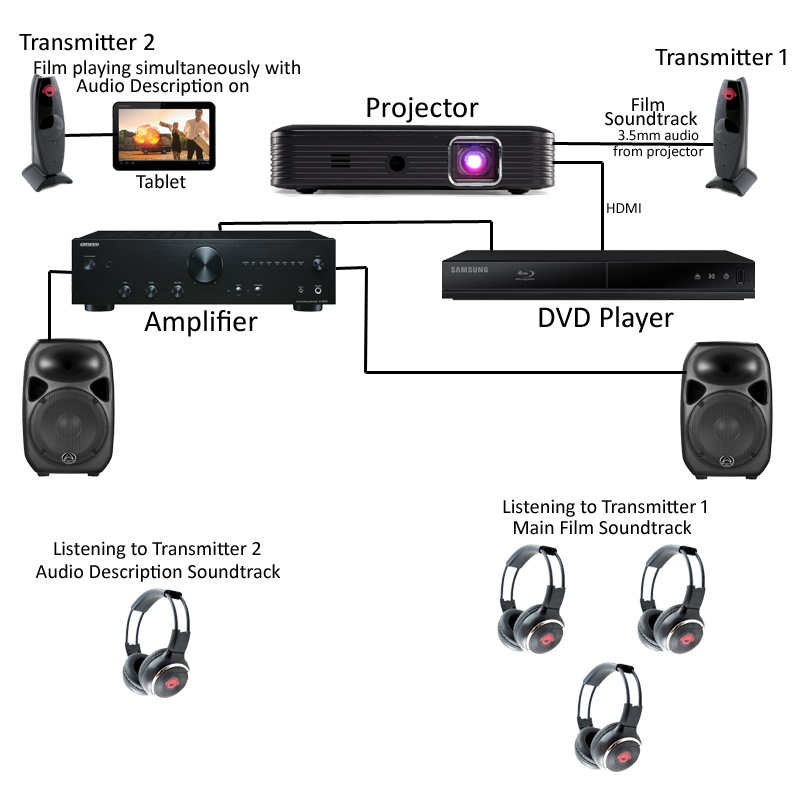Project overview
Community Cinemas operate on a tight budget and primarily screen from DVD using equipment aimed at the “home” market or a little better. Venues also are multi-use and not purpose built and therefore often suffer from poor acoustic qualities and do not offer tiered seating. However their audience demographic includes a significant proportion of people impacted by physical, social or economic exclusion, facing physical and economic barriers in attending commercial cinemas. This project is looking at low cost solutions that provide accessibility for hearing and visual impaired audiences attending community cinemas.
Why the project matters
It is estimated that there at least 696 community cinema locations around the UK. These venues provide around 6,400 screenings a year, generating over 329,000 admissions, with box office revenue totalling over £1.6 million (2016 data). They are generally located in areas of the country where arts and cultural provision may otherwise be limited and they help to address physical, social and cultural exclusion by overcoming some of the physical and economic barriers that prevent people attending commercial cinemas.
However, whilst they remove the physical and economic barriers associated with location, the venues are often not equipped to provide solutions for impairments that require additional support for hearing or sight. The primary age group for Community Cinema is over 55, a group that will have a significant additional range of age related hearing and visual impairments. Our community venues have anecdotal evidence of previously avid audience members no longer attending because they cannot hear the dialogue clearly, and also where audience members have attended once but not returned for the same reason. Switching on the Closed Captions for all screenings can help, but the lack of tiered seating makes viewing the captions difficult beyond the front row. It can also lead to an alienation of those who do not like to watch films with subtitles. If community cinema is to provide for all of the excluded groups it needs to have a cost effective method for delivering accessible content.
Aims
- To provide wireless audio headphones for hearing impaired audience members at all screenings
- To provide personal induction loop for hearing aid users at all venues not equipped with venue induction loop system.
- To use the same wireless headsets to offer audio described films for those with visual impairment.
- To deliver a Closed Caption service that can be provided at all screenings, be viewable from all non-tiered seating and without impacting audience members that would be deterred by the current CC method employed on domestic DVD screenings.
Headline results
We are currently trialing wireless headsets for personalised film sound track audio and a personal induction loop for hearing aid users. We have used a low cost silent disco solution plugged into the projector audio out socket transmitting wireless over ear headsets and personal induction loop receivers.
We are also looking at using the same wireless headsets to offer audio described films for visual the impaired. Our final project aim is to deliver a Closed Caption service that can be provided at all screenings, be visible from all seats in non-tiered venues and not impacting audiences members that would be deterred by the current CC method employed on domestic DVD screenings.
Key partnerships
Film Hub Scotland, Regional Screen Scotland, DGUnlimited
Budget
£3,500
Learning outcomes
What worked
Wireless headsets that deliver the film soundtrack direct to the user with personalised volume settings. These only work effectively where they are noise cancelling, full ear enclosure headphones. Personal induction loop receivers have worked where the audience member is able to access the T setting on their personal hearing aid; however we found that a lot of older audience members were not aware of how to access this feature.
What didn’t work
In ear headphones, and soft foam on ear headphones were not effective as they allowed “echo” from the outside audio. We have not yet trailed audio description as we need to establish a method of extracting the audio description track to a separate amplifier/transmitter. We understand that Commercial Cinemas utilise track 8 of a 9.1 sound system to deliver this content, but most of our systems operate 2.1, 3.1 or 7.2 audio. We are yet to find a method for alternative delivery of closed captioning.
What you’d do differently if you did it again
The project is on-going.







